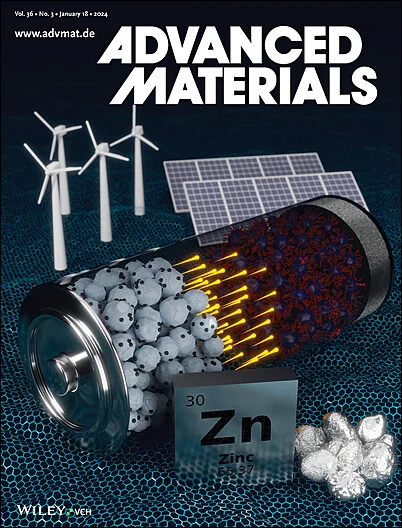利用聚阴离子策略实现mof基锌离子固态电解质中单价ZnCl+离子的超快输运。
IF 26.8
1区 材料科学
Q1 CHEMISTRY, MULTIDISCIPLINARY
引用次数: 0
摘要
高价离子的固态传输是一个巨大的挑战,例如二价锌离子的传输。本文提出了一种聚阴离子策略,将二价Zn2+还原为单价ZnCl+,实现了固态电解质中的超快离子传输。设计并构建了一种非晶金属-有机骨架(ZGB-MOF)作为固态电解质的基体。ZGB-MOF基体采用Zn2+/Ga3+竞争配位工艺,富集了O- ga - cl聚阴离子团簇、纳米孔和C = O/氧空位活性位点。Ga3+的聚阴离子性质和纳米孔的物理限制域促进了ZnCl+的形成。丰富的C = O和氧空位提供了更多的输运位点,降低了ZnCl+的输运能垒(只有0.12 eV)。最终得到的锌离子固态电解质(ZGBC)离子电导率达到5.2 × 10-3 S cm-1,迁移数达到0.873。更重要的是,ZGBC电解质具有宽的电化学窗口(高达2.88 V)和高的充电电压(2.4 V),实现了金属锌的无枝晶沉积和正极材料的稳定。ZGBC电解液和六氰高铁酸锌阴极的全电池表现出优异的循环稳定性,在5000次循环后没有容量下降。这一发现可能会引发探索二价Zn2+输运之外的新离子输运机制的新浪潮。本文章由计算机程序翻译,如有差异,请以英文原文为准。
Achieving Ultrafast Monovalent ZnCl+ Ion Transport in MOF-Based Zn Ion Solid-State Electrolyte through Polyanion Strategy.
Solid-state transport of high-valence ions is a huge challenge, such as the transport of divalent zinc ions. Herein, a polyanion strategy is proposed to decrease divalent Zn2+ to monovalent ZnCl+, realizing ultrafast ion transport in solid-state electrolyte. An amorphous metal-organic framework (ZGB-MOF) is designed and constructed as the matrix for solid-state electrolyte. The ZGB-MOF matrix is obtained by the Zn2+/Ga3+ competitive coordination process, enriching O-Ga-Cl polyanion clusters, nanopores and C═O/oxygen vacancies active sites. The polyanion property of Ga3+ and physical limiting domains of nanopores promote the formation of ZnCl+. Abundant C═O and oxygen vacancies provide more transport sites, decreasing transport energy barriers for ZnCl+ (only 0.12 eV). Eventually, the obtained Zinc ion solid-state electrolyte (ZGBC) achieves high ionic conductivity of 5.2 × 10-3 S cm-1 and high transference number of 0.873. More importantly, the ZGBC electrolyte exhibits wide electrochemical window (up to 2.88 V) and high charging voltage (2.4 V), and achieves dendrite-free deposition of Zn-metal and stabilization of cathode materials. Full cells with ZGBC electrolyte and zinc hexacyanoferrate cathode exhibit excellent cycling stability, with no capacity degradation after 5000 cycles. This discovery could trigger new waves of enthusiasm for exploring new ion transport mechanisms beyond divalent Zn2+ transport.
求助全文
通过发布文献求助,成功后即可免费获取论文全文。
去求助
来源期刊

Advanced Materials
工程技术-材料科学:综合
CiteScore
43.00
自引率
4.10%
发文量
2182
审稿时长
2 months
期刊介绍:
Advanced Materials, one of the world's most prestigious journals and the foundation of the Advanced portfolio, is the home of choice for best-in-class materials science for more than 30 years. Following this fast-growing and interdisciplinary field, we are considering and publishing the most important discoveries on any and all materials from materials scientists, chemists, physicists, engineers as well as health and life scientists and bringing you the latest results and trends in modern materials-related research every week.
 求助内容:
求助内容: 应助结果提醒方式:
应助结果提醒方式:


